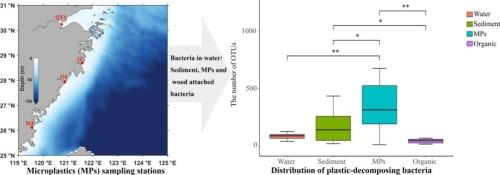微塑料选择性地丰富了河口中潜在的塑料降解细菌
IF 4.9
3区 环境科学与生态学
Q1 ENVIRONMENTAL SCIENCES
引用次数: 0
摘要
作为河流和海洋之间的过渡地带,河口是数百万吨陆基微塑料(MPs)进入海洋的关键途径。这些动态系统促进了MPs的重要转化过程,特别是通过它们与微生物群落的相互作用。然而,塑料圈的动态,特别是它如何在不同类型的河口之间变化以及对季节性环境变化的响应,仍然知之甚少。为了弥补这一知识空白,我们在春秋两季分别从钱塘江、椒江、瓯江和闽江四个主要河口采集了综合样本。分析了与水、沉积物、MPs和颗粒有机物(木材)表面相关的微生物多样性。结果表明,春季各河口MPs上的细菌种类不同,秋季变化不显著。MPs上的细菌多样性与水或沉积物样品有显著差异,但与颗粒有机物的模式相似,优势种在MPs上更丰富。MPs上的真核生物多样性与水中的相似,尽管在水中发现了更多特定的真菌种类。尽管有这些相似之处,与其他三种基质相比,MP表面上的细菌表现出更高水平的外生生物降解和代谢。物种分类和功能注释显示,潜在的塑料降解细菌在MPs表面的比例较高,这表明潜在的塑料降解细菌在MPs上的富集是由它们与塑料降解的直接关联驱动的,而不是它们的浮游状态或表面附着。本文章由计算机程序翻译,如有差异,请以英文原文为准。

Microplastics selectively enrich potential plastic-degrading bacteria in estuaries
Being the transition zones between rivers and the ocean, estuaries are critical pathways for the transport of millions of tons of land-based microplastics (MPs) into the ocean. These dynamic systems facilitate significant transformation processes for MPs, particularly through their interactions with microbial communities. However, the dynamics of the Plastisphere, particularly how it varies across different types of estuaries and in response to seasonal environmental changes, remain poorly understood. To address this knowledge gap, comprehensive samples were collected from four major estuaries (Qiantangjiang, Jiaojiang, Oujiang, and Minjiang River Estuaries) in Southeast China during both spring and autumn. The diversity of microorganisms associated with water, sediment, MPs, and particulate organic matter (wood) surfaces was analyzed. Our results indicated that bacterial species on MPs varied across estuaries in spring but exhibited no significant variation in autumn. The bacterial diversity on MPs was significantly different from that in water or sediment samples, but exhibited a similar pattern to that on particulate organic matter, with dominant species being more abundant on MPs. Eukaryotic diversity on MPs closely mirrored that in water, although more specific fungal species were found in the water. Despite these similarities, bacteria on MP surfaces exhibited higher levels of xenobiotic biodegradation and metabolism compared to the other three matrices. Species classification and functional annotation revealed a higher proportion of potential plastic-degrading bacteria on MP surfaces, indicating that the enrichment of potential plastic-degrading bacteria on MPs was driven by their direct association with plastic degradation, rather than their planktonic state or surface attachment.
求助全文
通过发布文献求助,成功后即可免费获取论文全文。
去求助
来源期刊

Marine pollution bulletin
环境科学-海洋与淡水生物学
CiteScore
10.20
自引率
15.50%
发文量
1077
审稿时长
68 days
期刊介绍:
Marine Pollution Bulletin is concerned with the rational use of maritime and marine resources in estuaries, the seas and oceans, as well as with documenting marine pollution and introducing new forms of measurement and analysis. A wide range of topics are discussed as news, comment, reviews and research reports, not only on effluent disposal and pollution control, but also on the management, economic aspects and protection of the marine environment in general.
 求助内容:
求助内容: 应助结果提醒方式:
应助结果提醒方式:


